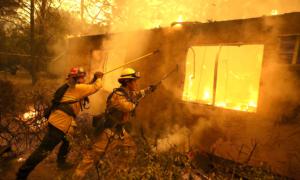California’s homeowners insurance crisis has left even some fire stations without coverage, which left lawmakers in shock during a recent Cal Fire budget discussion.
The issue came up in a discussion about the costs to modernize some firefighter and emergency response facilities, during which an official with the California Department of Finance told lawmakers an $11 million project in Tehama County at the Cal Fire Ishi Conservation Camp was unable to secure bonds. The reason, according to the official, is that insurers including the state’s last resort Fair Plan couldn’t cover the facility to the bond underwriter’s required level.
“The insurance industry, they weren’t interested in selling insurance policies in the region due to the perceived fire risk in the area,” Finance Department analyst Victor Lopez said during the meeting.
Tehama County is in northern California; the Ishi camp is about 150 miles north of Sacramento.
Given the recent news, both Cal Fire and the Finance Department have begun reviewing similar projects at other stations, Cal Fire Deputy Director Mike McGinness said during the meeting.
The Fair Plan provides basic coverage when other insurers aren’t available, but premiums are usually much higher. The plan now insures about 373,000 properties, adding 15,000 in February alone—the most ever. The plan has doubled in size since September 2019, officials said during an Assembly Insurance Committee meeting last month.
During that meeting, a representative for the Personal Insurance Federation of California said that if a wildfire in California cost the Fair Plan $4 billion today, it could absorb only half of that, and private insurers would be on the hook for the remaining $2 billion.
The decision will begin to affect policyholders on a rolling basis beginning in July for homeowner, community association, and business owner policies, and beginning in August for commercial apartment policies, State Farm officials said.
In a September 2023 statement, California Insurance Commissioner Ricardo Lara announced new rules for the industry, to be implemented by the end of 2024, that require insurers to write at least 85 percent of their policies in high-wildfire-risk and “underserved” communities, as part of what the state is calling its California Sustainable Insurance Strategy, which aims to expand insurance options in the state.
He also announced a new regulation on March 14 that would ease a restriction on insurers that prevents them from using forward-thinking models to set rates. In 1988, California passed a measure that required insurers to use data based on the past 20 years to set rates.







